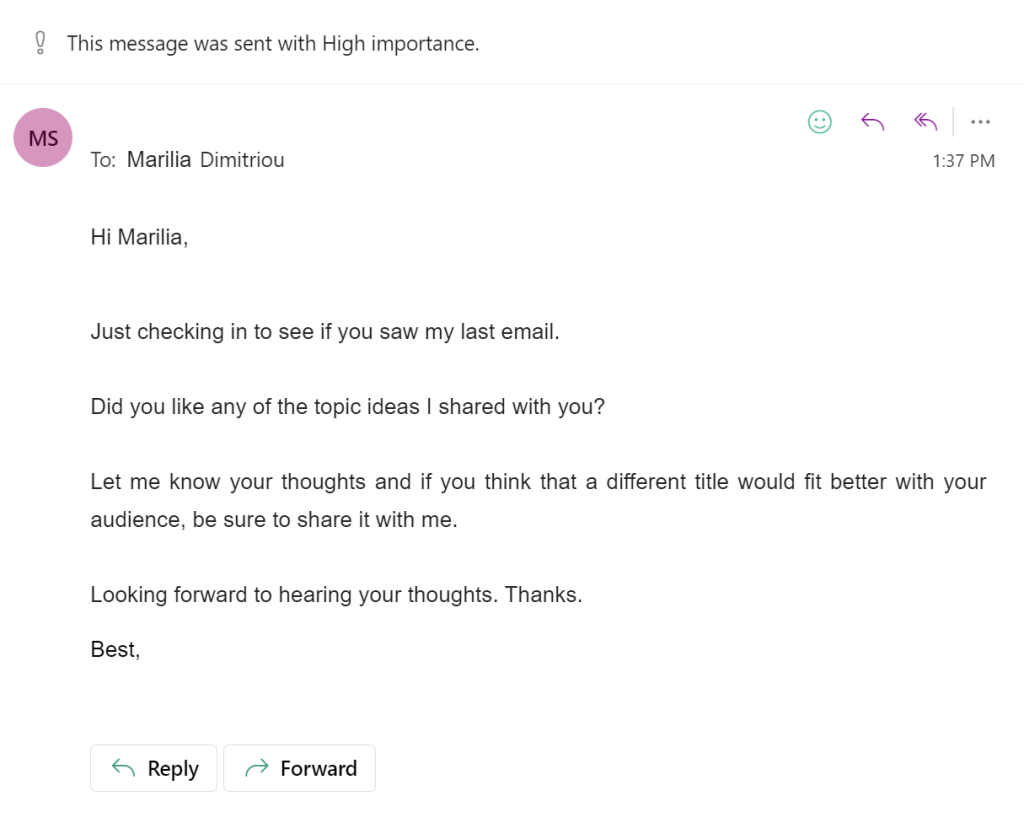You want to follow up with your contacts and your natural impulse is to start with “just checking in.”
Yet, you have concerns. Is it professional enough? What if your readers overlook your email?
Well, worry not. This guide will show you how to say just checking in professionally without using the actual thing.
Why You Should Avoid Saying “Just Checking in”
Business follow-up emails aim at getting a response or specific reaction from a recipient. For instance, marketers want to know if a customer has checked an offer or needs more information to act.
Below, you can see an example of such a follow-up message.
Many English-speaking professionals will choose to begin their emails with this phrase to be polite and thoughtful. Although there isn’t anything wrong with it, the recipients tend to overlook and ignore it.
Here are the main reasons why:
- It doesn’t stand out: According to a survey, US professionals receive 170 business emails per week, so if you don’t grab their attention from the get-go, your email will blend in with the rest.
- It’s unnecessary: The act of sending “checking in” messages will feel repetitive in the end.
- It isn’t genuine: Being honest and straightforward about the reason behind following up will positively impact the open rates, as your readers likely won’t find your email intrusive.
- It isn’t valuable: Every email needs to deliver value–be it insights, checklists, or more. And beyond this, decision-makers value conciseness, precision, and a clear call to action.
While asking about their well-being will add a more personal touch to your message, and give your readers a reason to respond instead of checking in with them. This will increase your chances of success.
Now, let’s discover some alternatives to “just checking in” emails.
Best Alternatives to “Just Checking in” Emails
There are many reasons to follow up with your subscribers or contacts, from asking for feedback on a product to promoting a new app feature, extending a product trial, and so on.
However, the key to writing a good follow-up message is to be intentional and clear, favoring approachability and friendliness.
Here are the key components to include in each email:
- Compelling subject line
- Appropriate greeting that fits your brand voice and communication style
- Important details about the reason you’re checking in
- Value for your reader
- Specific call to action (CTA)
- Proper email sign-off and signature with your name, title, and company name
In view of this, here’s how to follow up in different situations. Keep in mind that you might want to adjust the tone of voice and communication style of the following templates to your company’s brand voice.
1. Give an exclusive offer or promotion
Your subscribers have already expressed interest in your products or services by signing up for your email list. So instead of starting your email with “just checking in,” go ahead with the special incentive you want to offer right from the beginning.
Use case: Here’s what an exclusive discount email for one of your products or services could look like.
Subject line: For Your Eyes Only: Exclusive Discount (as a thank you for being here)
Email copy:
Hello [name],
Are you ready for your [what do your subscribers strive for] in [year]?!
As you may know, we have recently launched a new [product name].
To show you how thankful we are that you’re a member of our community, we’re offering you a special [X]% discount, exclusive to [whom your discount is exclusive for].
If you’re interested, all you need to do is [explain how they can activate the discount].
Thank you for being a part of our collective.
[Signature]
Example: Below, you can see a special starting offer from Originality.AI. See how the company crafted a simple message with a clear CTA? They even added social media links to give subscribers different ways to engage with them.
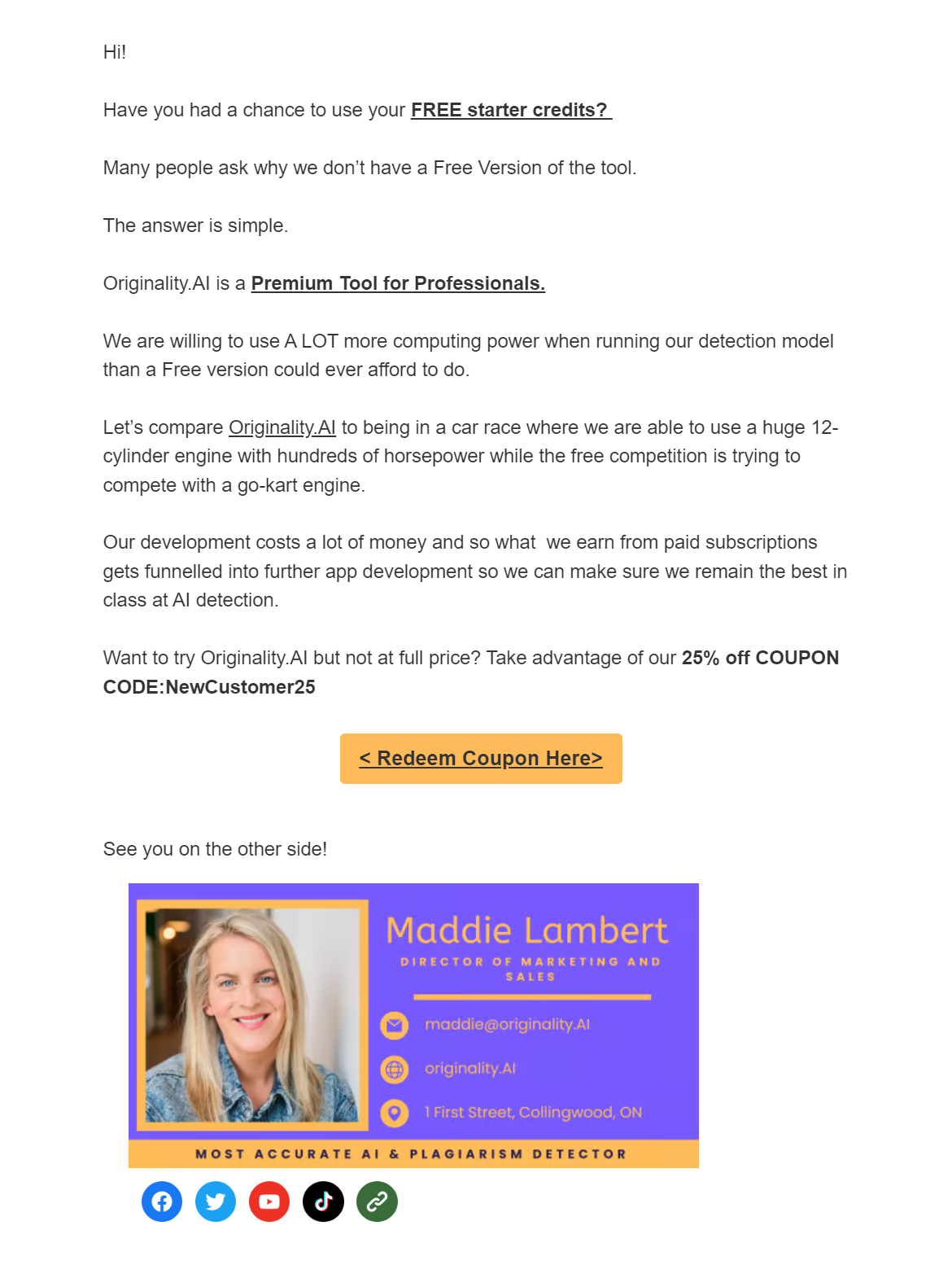
If you want to create beautiful emails like the above, you can get your hands on an email marketing platform like Moosend.
This email service will equip you with a user-friendly editor, allowing you to craft plain text messages and HTML campaigns for your subscribers. You can try the email builder and the pre-made templates by signing up for a free account.
2. Follow up on a specific action
Whatever status update you’re going for, your email should be short and on point. Also, it should include as many elements listed above as possible.
Use case: Here’s what your “just checking in” email could look like if you wanted to follow up on a meeting or a video call with a potential or existing client.
Subject line: Follow-up on our meeting on [meeting time]
Email copy:
Dear [name],
Once again, thank you for meeting me at [time of the meeting]. It was a pleasure.
We discussed the opportunity for your company to [discussion points] by [discussion points].
Here is the link to [helpful materials, e.g., case study, blog post, video, etc.] so you can see how our [product or service] can help with [pain points] by [summary of key points from the materials].
If you’re interested, [CTA describing the next steps to take].
[Signature]
3. Suggest a networking opportunity
Some of your subscribers may be thrilled to meet you in person. That’s why this check-in email type is a great way to establish stronger connections with them.
But why ruin it by starting your email with a generic: “Just checking in?”
Use case: Here’s an email template to invite your subscribers to your networking event.
Subject line: Your invite to the [event name]
Email copy:
Hello [name],
Ready to [describe the main benefit of joining the networking event]?
This is your invitation to join us for [event name], on [event time] at [event location].
At this networking event, you’ll have a chance to [number or list the highlights of the event].
Also, you’ll get to mingle with some of the most renowned professionals in the industry.
Use [registration link] to secure your spot.
We can’t wait to see you in person.
[Signature]
Template: Moosend offers an array of pre-made email templates to help you craft your follow-up messages. You can easily customize one of the event invitation designs like the one below and use the email copy above to save time and effort.
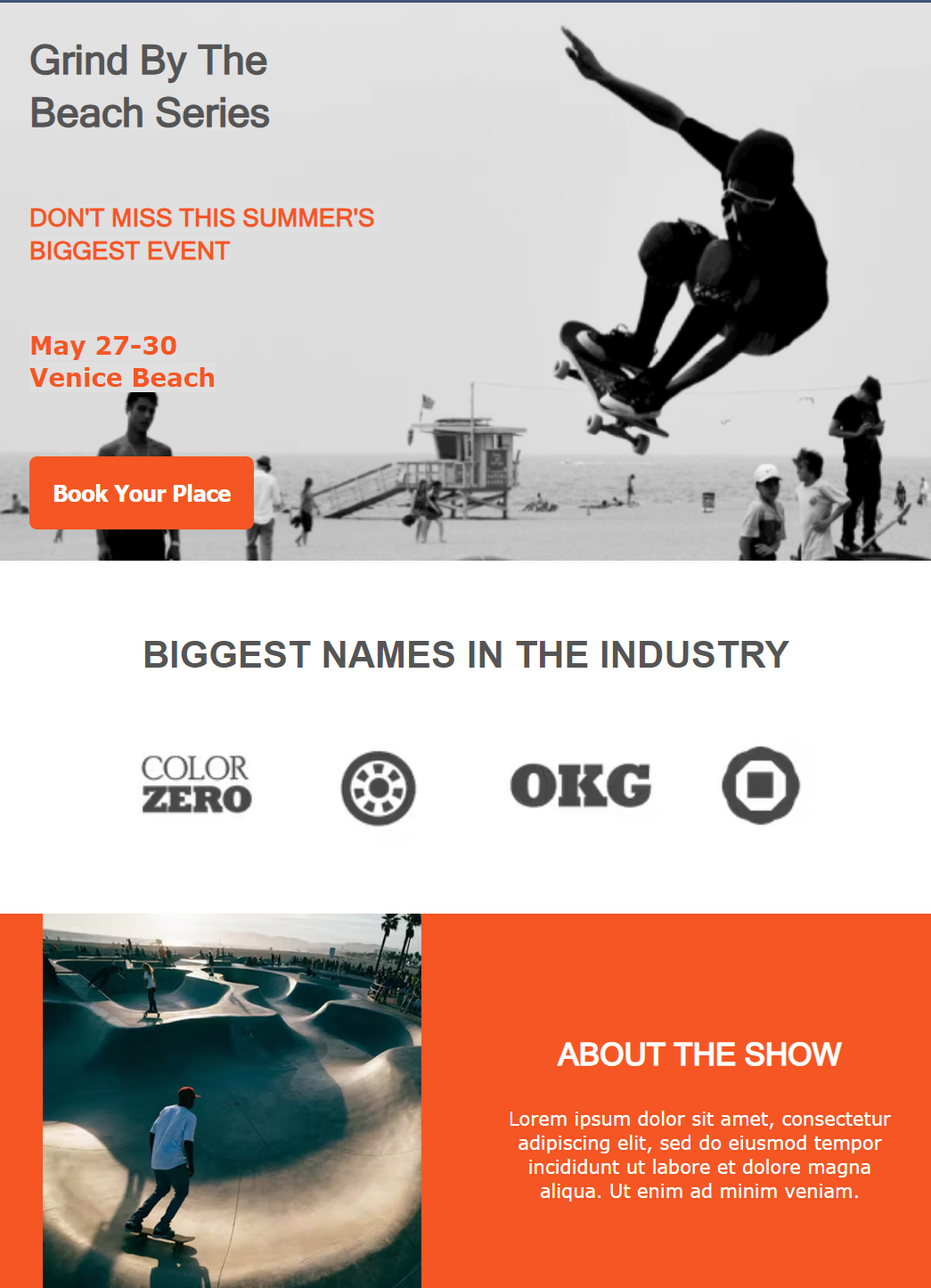
4. Share resources or insights
When you generously share valuable content with your contacts, you decrease the likelihood of them perceiving your email as intrusive or overlooking it. Below, you’ll find another great alternative on how to say just checking in professionally.
Use case: Let’s say you want to send additional resources to the prospect you had a call with.
Subject line: Additional resources related to [subject of the original meeting or call]
Email copy:
Dear [name],
Once again, thank you for the lovely conversation. I hope you found it helpful.
To further support you in your efforts to [recipient’s goal], I would like to share an additional resource.
In [link to resource] you can learn how to [brief description of main takeaways].
If you have questions or would like to discuss [original meeting’s topic] further with me, feel free to [link to book a call] at your convenience.
Looking forward to hearing from you.
[Signature]
6. Request feedback
The elements to include in your “just checking in” email when asking for feedback are much the same as when following up on a specific action.
Use case: Let’s say you want to find out more about your new subscribers.
Subject line: Take our 2-minute survey
Email copy:
Dear [name],
Once again, thank you for signing up for [service]. If you still haven’t had the chance to check it out, please do so by clicking [link].
Also, we’d love to know more about you and your goals by taking the following [survey or questionnaire link], so that we can improve your experience.
Thank you so much for your time!
[Signature]
Example: Below you can find a real survey follow-up email from Substack. See how the message is short and on point, with a bright CTA that’s hard to miss?
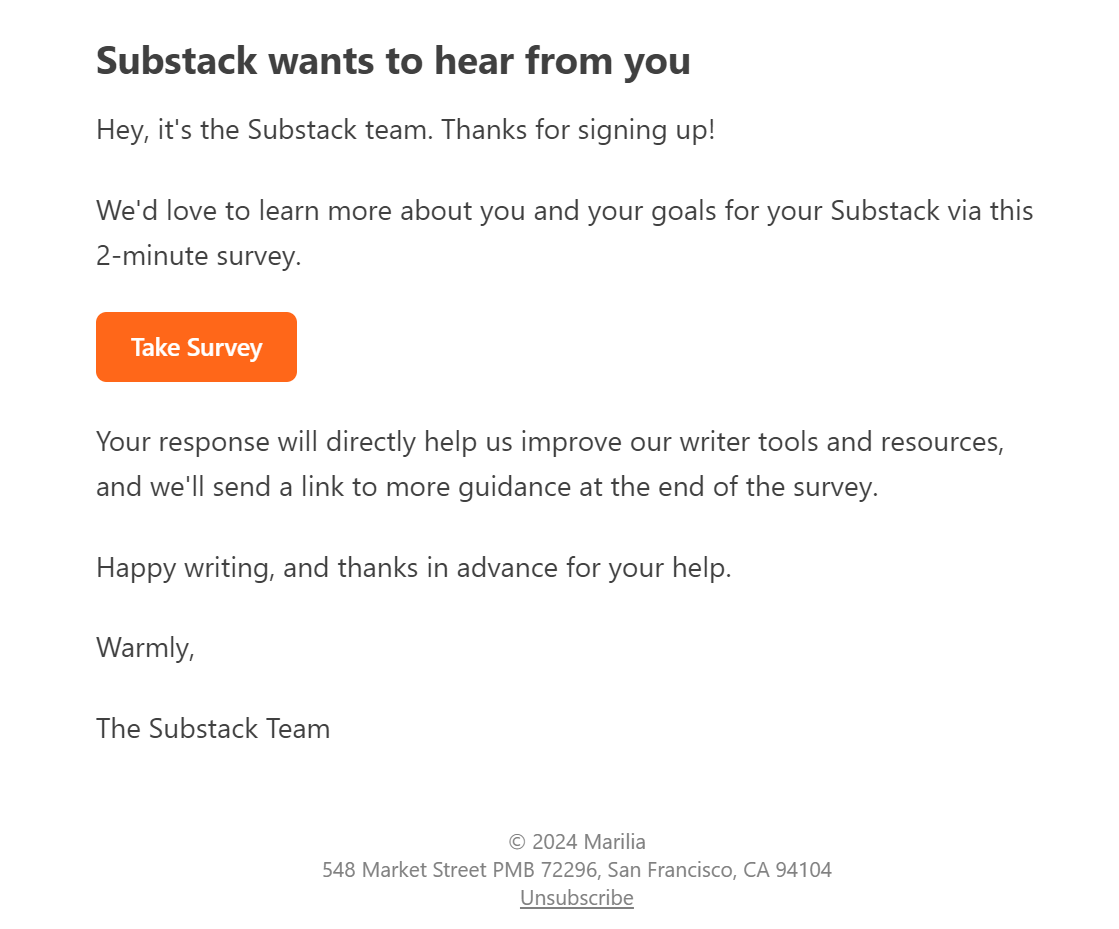
6. Offer assistance
Offering assistance is an amazing way to engage with your subscribers, customers, clients, or colleagues, without coming across as overeager.
For example, you can offer to support them after you have:
- Had a meeting
- Sent a proposal
- Sent additional resources or insights
- Sold one of your products
- Hired them
- Demonstrated a new feature
…and the list goes on. Here’s how to say just checking in professionally using a great alternative.
Use case: Let’s say you’re offering to support your customers after they have purchased your software.
Subject line: Need support with [product name]? We’re here for you.
Email copy:
Dear [name],
Once again, thank you for choosing [product name] for [the software’s purpose].
We appreciate you choosing our solution!
I’m reaching out to ensure you have a smooth experience with [the software’s name].
Here’s a brief [tutorial] (include the appropriate link) on how to use it. (In case you still haven’t had a chance to check it out).
If you have any questions or concerns, face challenges, or need help, don’t hesitate to reach out.
Our team is committed to your satisfaction.
[Signature]
7. Invite to an industry event or webinar
The key to getting a positive answer to any event invitation email is highlighting what your invitees can expect from the event. The same goes for following up with webinar invites.
Use case: Let’s say you want to invite your subscribers to a once-a-year business event.
Subject line: You’re invited! Join us for the event of the year – [event name]
Email copy:
Dear [name],
Before you know it, the time for our annual [event name] has come, and we’re excited to invite you.
We’re thrilled to announce that after our CEO’s welcome message, [speaker’s name, title, and role in your industry] will share [his/her/their] insights on the topic of [the name of the topic].
Other speakers include [speakers’ names], so you can expect to [describe the main benefits of attending the event].
[event name] will take place on [event time] at [event venue].
If you’re interested, please register at the link below.
[Button to the registration link]
We’re looking forward to seeing you!
[Signature]
Template: You can use the email template with a quick design to create a beautiful webinar invitation for your audience.
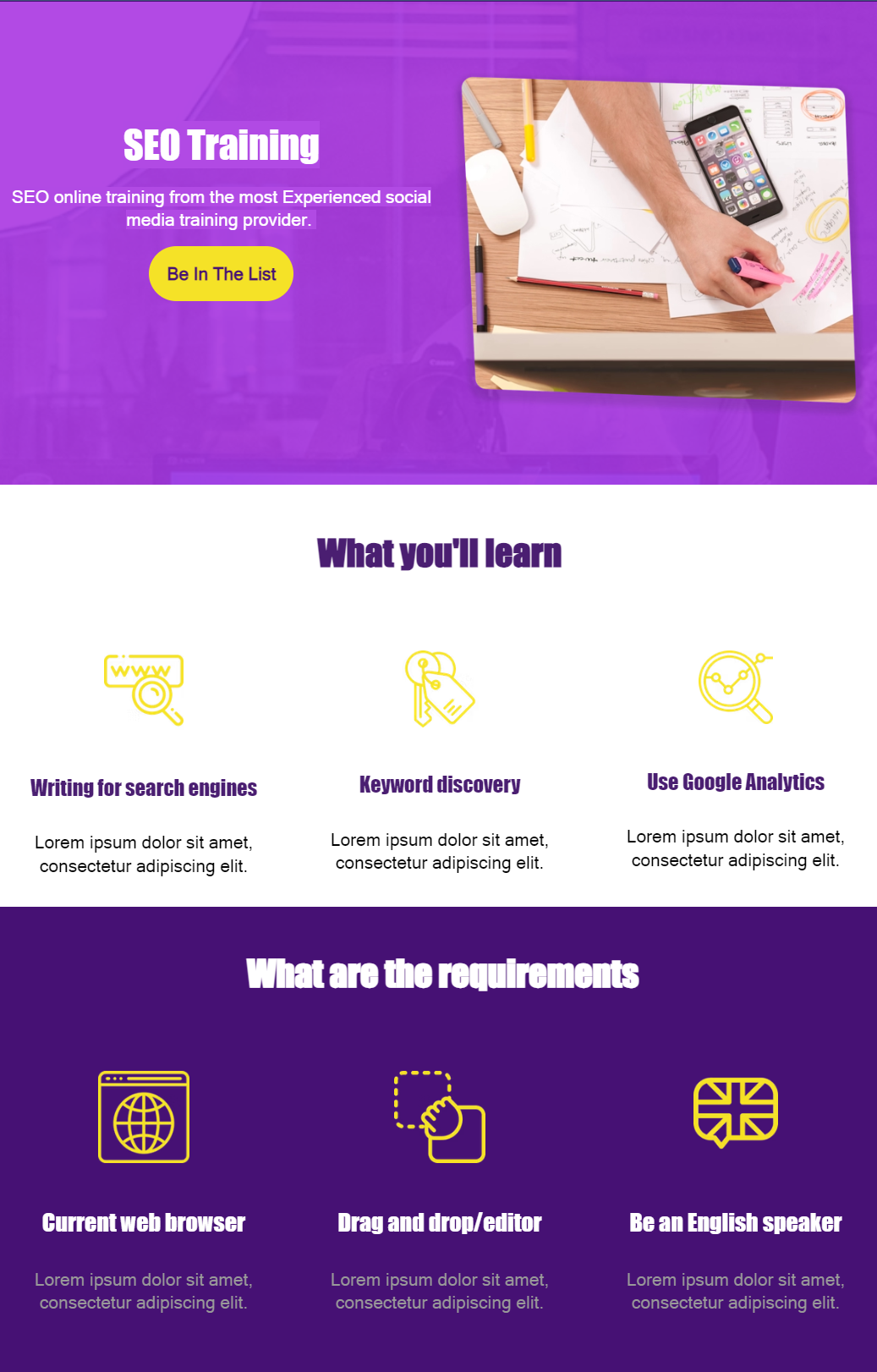
To send your campaigns, you will need a Moosend account. So, make sure to sign up for the 30-day free trial here.
8. Showcase the success stories of other clients
Nothing will promote your business and brand more effectively than your customers’ success stories.
Use case: Showcase a blog post, video, or case study of how you helped your client solve a problem similar to what your subscribers face.
Subject line: From [problem] to [solution] in [the time it took]. This is how we helped [client’s name] do it.
Email copy:
Hey, [name],
Are you struggling with [subscribers’ pain points]?
This is [client’s name]. They were able to [the result] with the help of our [product name] in [the time it took].
Would you like to know how?
Click [link to the resource] to see their journey and how you can achieve the same…
[Signature]
Now that we have seen some great touch-base alternatives, let’s see some of the benefits of follow-up emails and common pitfalls to avoid.
What Are the Benefits of a Follow-Up Email?
Research shows that the first follow-up email can increase the response rate by 49%.
Also, it’s worth noting that 50% of sales occur after the fifth follow-up. This highlights the importance of sending well-crafted email sequences.
Ultimately, the key aspect of effective messages is to nurture a meaningful relationship with your contacts.
Here’s how follow-up emails help you do just that.
Building brand awareness and trust
Sending relevant and helpful follow-up emails shows that you are committed to providing ongoing value.
This is how you “teach” your subscribers that they can rely on you, which helps increase your influence, builds a favorable reputation, and creates top-of-mind awareness.
Filtering your email list
If you notice subscribers who don’t open your follow-up emails, you can remove them from your list. That’s how you’ll keep all your emails from spam folders and maintain good email list hygiene.
Moreover, this will improve email deliverability, having a positive impact on the subscribers who do like reading your emails.
Boosting conversion rates
It takes between 5 to 8 follow-up touches on average to generate a conversion or meeting.
However, some subscribers may only buy from you after they have read your emails for months or even longer.
Now that you understand the benefits of follow-up emails, let’s tackle the next crucial question.
When Should You Send a Follow-Up Email?
Short answer? It’s case-specific.
A few factors play into how often and at what time to send your follow-up emails, such as who you’re following up with and why, as well as your usual communication and emailing style.
If you have an engaged email list, write to your subscribers regularly. More so if you often share helpful insights and resources with them.
However, here are a few specific cases when to follow up regardless:
- After you had a meeting with them.
- If they missed an appointment or a call with you.
- After they expressed interest in your products or services but went silent, and now you want to win them back.
- They said they’d get in touch but never did.
- You’ve previously sent them an email but didn’t receive a response.
- They abandoned a free trial, checkout, or account creation.
It can be hard to figure out when to check in without being too pushy. We recommend sticking to how you usually talk to your contacts. Alternatively, you can rely on customer data and insights to determine frequency.
Remember that sending a message within the right time frame will make a difference. The general rule is to email your contacts at least 3 days after the initial message or interaction.
You can send a sequence of a minimum of 5 emails, allowing enough time in between for the recipients to respond.
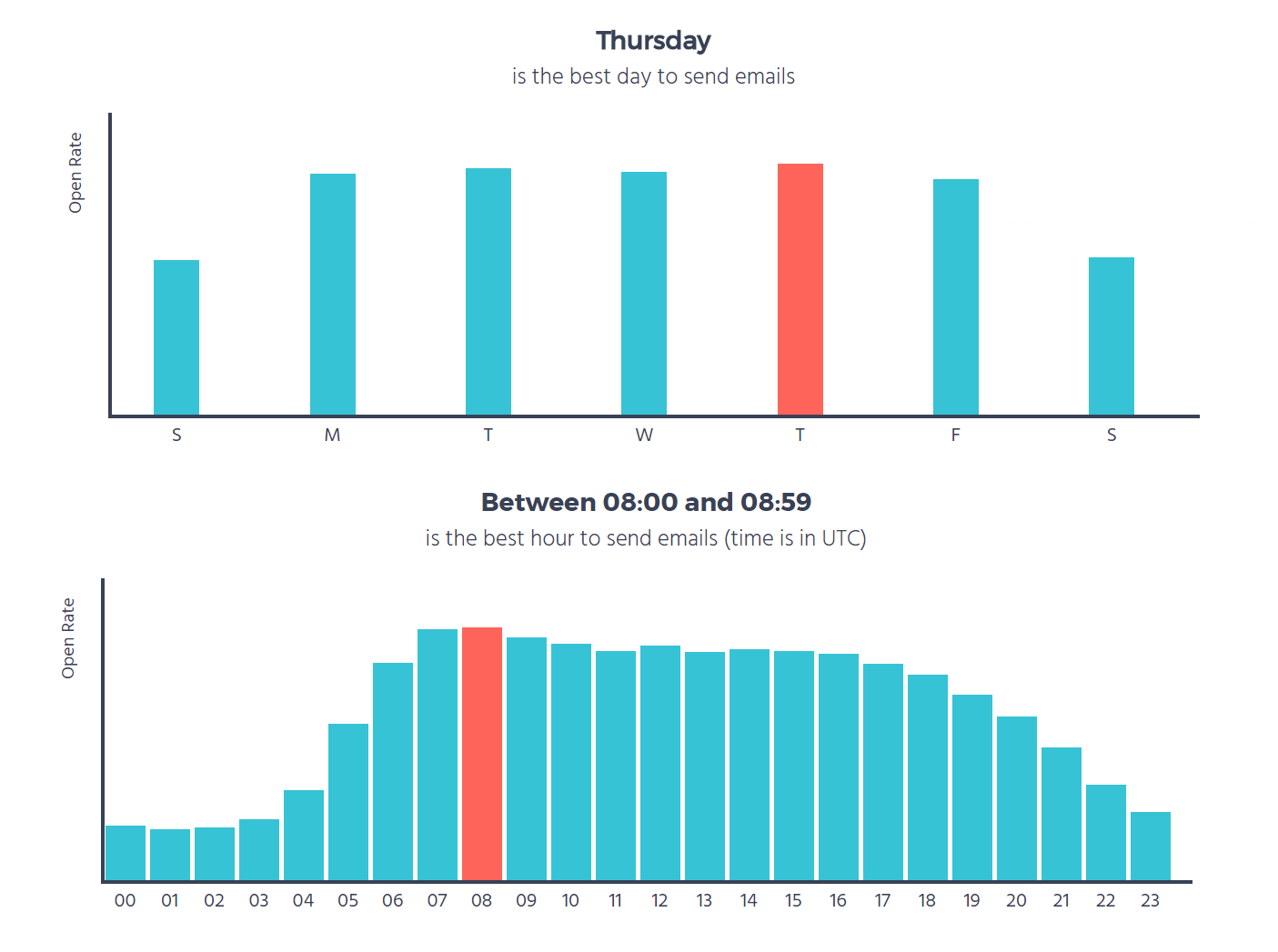
The best times to send your alternative to “just checking in” emails are Thursdays, between 8-9 AM (recipients’ time zones). However, it also depends on your industry.
Common Mistakes to Avoid When Following Up Professionally
The more effective the follow-up emails, the more chances you’ll have for your recipients to choose, open, and read yours. So, there isn’t much room for errors.
Here are a few common mistakes to avoid when following up:
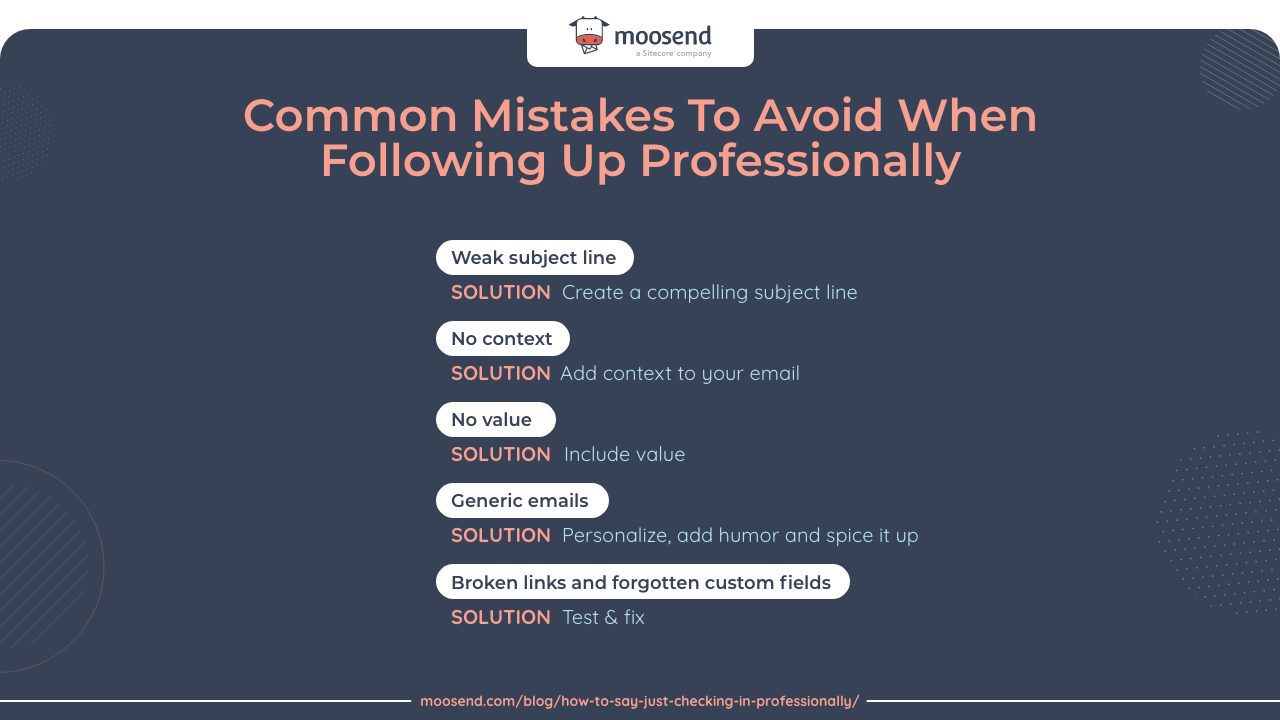
Weak subject lines
A weak subject line fails to communicate the reason for emailing, the context, the benefits for the recipients, or the purpose of the email.
And you certainly don’t want your subject lines to be misleading.
To write compelling email subject lines, follow these guidelines:
- Keep them short
- Communicate your intention
- Refer to your last email or previous interaction.
- If relevant, mention the benefit or value for the recipient.
To increase the success of your subject lines you can use a subject line tester. Tools like Refine will offer you valuable insights and suggestions for better open rates.
Lack of context
Ensure your check-in email refers to and recaps the previous interactions with your recipient, whether it was on LinkedIn, in person, or through a phone call.
This will save your reader time because they won’t have to remember the previous conversation on their own or search through emails, texts, and so on.
Recalling your past interactions or communications boosts your chances of getting the response you want.
No value
Before you invest your time and attention in anything, emails included, you may wonder: “What’s in it for me?”
Your contacts are no different, so include something of value to them in each email you send out.
Generic emails
Although using ready-made follow-up templates can save time, avoid relying on them completely because they appear generic and reduce the chances your recipients will read them.
Personalize your follow-up emails and whatever templates you’re using instead. Play with the format and tone of voice – in alignment with your brand identity, use humor if appropriate, and experiment to see what works best with your subscribers.
Broken links and forgotten custom fields
Test your email before sending it. Other than the links and custom fields, check for spelling and grammar mistakes, formatting, and visuals if included.
Creating More Professional Follow-Up Emails
Professional and mindful follow-up emails go a long way when nurturing trusting relationships with your contacts, building your brand, and increasing conversions.
Using better alternatives can make a difference and level up your marketing goals.
So now that you know what to say instead of “just checking in,” you can find out more about proper email etiquette and get actionable advice on email marketing to avoid common mistakes.
And if you want a tool to help you design and personalize your follow-up emails, with a plethora of integrations and good deliverability, you can sign up for a Moosend account today.
The post How To Say Just Checking In Professionally: 8 Alternatives [2024] appeared first on Email Marketing Automation Platform for Thriving Businesses.
